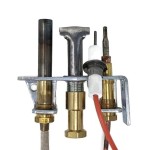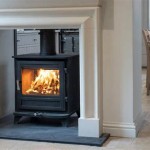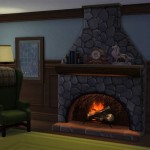Victorian and Edwardian Cast Iron Fireplace Mantel Surrounds: A Timeless Elegance
Victorian and Edwardian cast iron fireplace mantel surrounds represent a significant period in architectural and interior design history. Spanning from the mid-19th century to the early 20th century, these surrounds are more than mere functional elements; they are testaments to craftsmanship, aesthetic sensibilities, and the societal values of their time. Possessing an understanding of their historical context, design features, and the materials used is essential for appreciating their enduring appeal and for making informed decisions when restoring, preserving, or incorporating them into contemporary settings.
The Victorian era (1837-1901) was marked by rapid industrialization, increased urbanization, and a burgeoning middle class. This period saw the rise of mass production, influencing everything from clothing to furniture and architectural elements. Simultaneously, there was a strong emphasis on domesticity, comfort, and the display of wealth and status within the home. The fireplace, as the focal point of a room, became a prime canvas for showcasing these ideals.
The Edwardian era (1901-1910), while brief, followed the Victorian period and witnessed a slight shift in design aesthetics. While elements of Victorian opulence remained, there was a move towards lighter, more airy designs, influenced by the Art Nouveau and Arts and Crafts movements. Edwardian fireplace surrounds reflected this shift, often incorporating cleaner lines and more subtle ornamentation compared to their Victorian counterparts.
Materials and Construction
Cast iron was the primary material used in the construction of these fireplace surrounds. The process of casting involved pouring molten iron into molds, allowing for intricate designs and mass production. The inherent properties of cast iron, including its durability, heat resistance, and ability to hold fine detail, made it an ideal choice for fireplace surrounds. Foundries throughout Britain and Europe specialized in producing these surrounds, offering a wide range of styles and patterns to meet diverse tastes and budgets.
The casting process typically involved creating a wooden or plaster pattern of the desired surround. This pattern was then used to create a sand mold, into which the molten iron was poured. Once cooled, the cast iron components were removed from the mold, cleaned, and finished. This finish often included painting, enameling, or polishing to enhance the aesthetic appeal and protect the metal from corrosion.
The components of a typical cast iron fireplace surround included the mantelpiece (the shelf above the fireplace opening), the jambs (the vertical supports on either side of the opening), and the frieze (the decorative panel above the opening). These components were often cast separately and then assembled to create the complete surround. In some cases, decorative elements such as tiles, inlays, or overmantels (decorative structures above the mantelpiece) were incorporated to further enhance the overall design.
The weight of cast iron fireplace surrounds is considerable, requiring careful planning and installation. Proper support structures are crucial to ensure the stability and safety of the surround. Original installations often involved securing the surround to the wall with bolts or screws, and in some cases, incorporating brick or stone backing for added support.
Design Characteristics and Styles
Victorian and Edwardian cast iron fireplace mantel surrounds exhibited a diverse range of design styles, reflecting the prevailing aesthetic trends of their respective periods. Victorian designs often featured ornate detailing, including floral motifs, scrollwork, classical figures, and geometric patterns. The emphasis was on visual richness and the display of craftsmanship. Many Victorian surrounds were inspired by historical styles, such as Gothic Revival, Renaissance Revival, and Neoclassical.
Gothic Revival surrounds often featured pointed arches, trefoil motifs, and other elements reminiscent of medieval architecture. Renaissance Revival surrounds incorporated classical columns, pilasters, and pediments, drawing inspiration from the Italian Renaissance. Neoclassical surrounds, popular in the later Victorian era, emphasized symmetry, balance, and classical ornamentation, such as fluted columns, egg-and-dart moldings, and acanthus leaves.
Edwardian fireplace surrounds, while still often incorporating decorative elements, tended to be more restrained and elegant than their Victorian counterparts. The influence of the Art Nouveau movement was evident in the use of flowing lines, organic forms, and depictions of natural elements such as flowers, leaves, and insects. The Arts and Crafts movement, with its emphasis on simplicity, craftsmanship, and natural materials, also influenced Edwardian design, leading to surrounds with cleaner lines and less elaborate ornamentation.
Common decorative motifs found in Victorian and Edwardian cast iron fireplace surrounds included: scrolls, foliage, shells, anthemia (a stylized honeysuckle motif), griffins, lions, and portraits. The choice of motifs often reflected the homeowner's personal taste and social standing. The level of detail and craftsmanship varied depending on the price point and the intended location of the surround (e.g., a grand drawing room versus a more modest bedroom).
Color palettes for these surrounds varied depending on the period and the style of the room. Dark colors such as black, dark green, and dark brown were common in the Victorian era, often accented with gold or bronze paint to highlight the decorative details. Edwardian surrounds often featured lighter colors such as cream, white, and pastel shades, reflecting the desire for brighter and more airy interiors.
Identifying and Restoring Antique Fireplace Surrounds
Identifying a Victorian or Edwardian cast iron fireplace mantel surround requires careful observation of its design features, materials, and construction. Key indicators include the presence of cast iron, the style of ornamentation, the overall proportions, and any maker's marks or stamps. Consulting reference books, online resources, and experts in architectural antiques can be helpful in accurately identifying the period and style of a surround.
The condition of an antique fireplace surround can vary significantly depending on its age, exposure to the elements, and previous use. Common problems include rust, corrosion, damaged or missing components, and layers of paint or other finishes. Before undertaking any restoration work, it is essential to assess the condition of the surround and determine the appropriate course of action.
Restoration techniques for cast iron fireplace surrounds typically involve removing rust and corrosion, repairing or replacing damaged components, and applying a new finish. Rust and corrosion can be removed using a variety of methods, including wire brushing, abrasive blasting, and chemical treatments. It is important to choose a method that is appropriate for the condition of the metal and the desired aesthetic.
Repairing or replacing damaged components may involve welding, casting new parts, or sourcing original replacements. Welding should be performed by a qualified professional to ensure the structural integrity of the repair. Casting new parts requires creating a mold based on an existing component or a drawing. Sourcing original replacements can be challenging but may be possible through antique dealers, architectural salvage yards, or online marketplaces.
Applying a new finish to a restored fireplace surround is an important step in protecting the metal from corrosion and enhancing its appearance. Common finishes include paint, enamel, and polishing. Choosing the appropriate finish depends on the desired aesthetic and the historical accuracy of the restoration. It is important to use high-quality paints and finishes that are designed for use on metal and are resistant to heat and moisture.
Safety considerations are paramount when restoring and installing antique fireplace surrounds. Cast iron is a heavy material, and proper support structures are essential to prevent accidents. Working with power tools and chemicals requires the use of appropriate safety equipment, such as gloves, masks, and eye protection. It is also important to ensure that the restored fireplace surround meets current building codes and safety standards.

Buy Antique Neo Classical 19th Century Cast Iron Fireplace Surround

Cast Iron Mantels Surrounds Scarlett Fireplaces

Cast Iron Combination Mantels Victorian Fireplace

Antique Victorian Fireplaces Fire Surrounds Mantels

The Antique Fireplace Co Cast Iron Victorian Fireplaces

Victorian Cast Iron Fire Surround And Tiled Insert

Edwardian Cast Iron Combination Fireplace 48 Victorian

Fs0096 A Decorative Edwardian Cast Iron Fire Surround With Oak Mantel

Antique Cast Iron Fireplace Mantle Black And Wood Late 19th Century England Victorian Mantels

Edwardian Fireplaces Selection Of Antique For By Heritage Fireplace Centre








